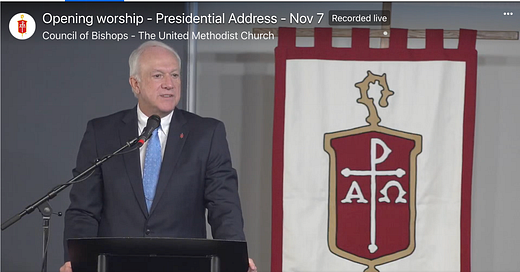Going multi-platform is har
UM Insight Screenshot from Council of Bishops’ Facebook Video
Dear readers, it turns out that finding a replacement for X (formerly Twitter) proved harder than we at United Methodist Insight anticipated. Nonetheless we forged on, adding Substack to our stable of social media outlets. Each week we’ll post excerpts from the weekly newsletter, encouraging you to sign up for the complete email version that includes images and RSS feed.
Here’s our first post:
Lamentation carries a heavy theological load in naming the pain and injustice of past wounds. Yet it also serves a key spiritual function by encouraging the release of emotion so that hearts, minds and souls can begin to recover. This week, United Methodists took more steps toward the denomination's future after the fractures of the past four years.
Signs of moving forward marked the annual address of the Council of Bishops president, Bishop Thomas Bickerton (New York Area) (see photo above). Framed by a service of healing from the United Methodist Book of Worship, he cited three venues – the October gathering in Cambodia of some 200 mission workers, the June session of the Texas Annual Conference, and John Wesley's departure from Anglican Church structure – that he said "enlivened" his view of the UMC's future after disaffiliation. Bishop Bickerton exhorted his colleagues to craft "narratives of hope" on the way to the 2024 General Conference to capture the renewal occurring in many places throughout the worldwide UMC.
Outlines of what shape the future UMC might take also emerged this week. Taylor W. Burton Edwards continued Ask the UMC's new series by looking at how regionalization "means connectionalism customized to enhance local effectiveness." Thus, writes Rev. Burton Edwards, regionalization would extend the UMC's current provisions that allow the church's bedrock theology, missiology and basic polity to be adapted outside the United States to meet local contexts.
At the same time, Global Ministries mission theologian David W. Scott asserts that the UMC is structured as a "rural" church in an increasingly urbanizing world. He posits that "classic elements of Methodist history – circuit riders, class meetings, camp meetings" – which helped spread religion along the U.S. frontier so successfully in the 19th century haven't been adapted to meet the needs of a highly technological urbanized 21st century. Dr. Scott says he'll explore possible alternatives to this dilemma in a future post.
Additional columnists this week:
My Word for Today is 'Pour' by Cindy Hickman
A Grateful People by Paul I. Burrow
Living With Confidence by Paul I. Burrow
The One Percent Church by Martin Thielen
Spirituality and the Pastor’s Dilemma by Rebekah Simon-Peter
You Are Incomparable! by Jim Burklo
Good Riddance? No, Weeping for the UMC's Pain, Loss by Mary John Dye
The Closer: This week's news and readers' comments on the website prompted the memory of the first stanza of Emily Dickson's poem, "'Hope' is the Thing with Feathers"
“Hope” is the thing with feathers -
That perches in the soul -
And sings the tune without the words -
And never stops - at all -
Stumbling as United Methodists are toward an unseen future amid a world in chaos, hope can be hard to hold. Yet, as a Facebook meme said this week, giving in to hopelessness merely gives evil its victory. For all the pain of past wounds and our skepticism about paths into a future, we continue to hope that our choices reflect God's will for our lives, individually and collectively. As Steve Harper counsels in his "Vigil" series, we keep watch for the coming of that for which we hope – the beloved community, the wholeness (shalom) promised to us by God.
We pray you find hope watching for – and finding – God's presence every day.
Find more content Monday through Saturday at United Methodist Insight.
um-insight@as-tex.net




